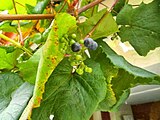Vitis coignetiae
| Crimson glory vine | |
|---|---|

| |
| Vitis coignetiae leaves | |
| Scientific classification | |
| Kingdom: | |
| (unranked): | |
| (unranked): | |
| (unranked): | |
| Order: | |
| Family: | |
| Subfamily: | |
| Genus: | |
| Species: | V. coignetiae
|
| Binomial name | |
| Vitis coignetiae | |
| Variety | |
| Synonyms | |
|
V. amurensis var. glabrescens (Nakai) Nakai [possibly syn. of V. coignetiae var. glabrescens, not V. coignetiae][1][2] | |
Vitis coignetiae (Crimson glory vine, 머루 meoru in Korean), and ヤマブドウ yama-budo in Japanese) is a plant belonging to the genus Vitis that is native to the temperate climes of Asia, where it can be found in the Russian Far East, (Sakhalin); Korea; and Japan (Hokkaido, Honshu, Shikoku). It was described botanically in 1883.[1]
History
The species name is dedicated to Mr. and Mrs. Coignet who reportedly brought seeds back from their trip to Japan in 1875.
This vine was also reported in 1884 snowy regions of Japan by Henri Degron sent to East Asia to seek wild vines resistant to Phylloxera. Degron sent specimens to a Professor Planchon of Montpellier who named them Vitis coignetiae but did not retain them due to their low resistance to phylloxera. Degron planted a vineyard in Crespières, Île-de-France where one of the vines reached a length of 32.8 meters and a height of 2.8 meter. In the cooler Norman climate the vine produces a bitter wine, rich in color and extract.
Description
The vine is very vigorous, with purple shoots.The deciduous leaves are large (15 to 30 cm in diameter), simple, orbicular, toothed, with deep petiole. First green, they turn red-orange in autumn.
Wild vines can be male, female or hermaphrodite. Clusters are large with small berries and large purple seeds. It is found in the mountainous regions of Japan and up to 1300 m altitude in Korea.
Uses
In East Asia it is grown as an ornamental plant for its crimson autumn foliage; and as an Oriental medicinal plant.
It is used to produce wines in Korea and Japan. These are at first bitter, but softened with the addition of sugar.
Chemistry
The plant contains the stilbenoids ε-viniferin[citation needed] and rhapontigenin.[3]
Gallery
- Vitis coignetiae
-
Vitis coignetiae leaves.
-
Vitis coignetiae vine growing in Cheshire, United Kingdom.
-
Vitis coignetiae fruit cluster.
-
Vitis coignetiae berries.
-
The ornamental grape autumn colors. Growing in Victoria, Australia.
-
Vitis coignetiae in Northern France.
Sources
- ^ a b c d GRIN (May 23, 2009). "Vitis coignetiae information from ARS/GRIN". Taxonomy for Plants. National Germplasm Resources Laboratory, Beltsville, Maryland: USDA, ARS, National Genetic Resources Program. Retrieved October 20, 2009.
- ^ a b GRIN (May 23, 2009). "Vitis coignetiae var. glabrescens information from ARS/GRIN". Taxonomy for Plants. National Germplasm Resources Laboratory, Beltsville, Maryland: USDA, ARS, National Genetic Resources Program. Retrieved October 20, 2009.
- ^ Jung, D. B.; Lee, H. J.; Jeong, S. J.; Lee, H. J.; Lee, E. O.; Kim, Y. C.; Ahn, K. S.; Chen, C. Y.; Kim, S. H. (2011). "Rhapontigenin inhibited hypoxia inducible factor 1 alpha accumulation and angiogenesis in hypoxic PC-3 prostate cancer cells". Biological & Pharmaceutical Bulletin. 34 (6): 850–855. doi:10.1248/bpb.34.850. PMID 21628883.
See also






